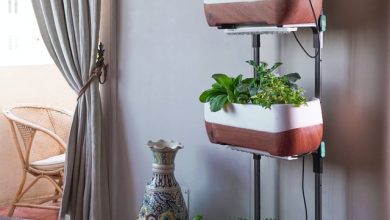How to Create Your Own Rooftop Garden

Gardens come in all shapes and sizes, representing the personal preferences and style of each gardener who shapes them. Of course, gardens are different all over the world, and there are all kinds of different garden designs to consider for your own space.
One garden design, in particular, has only become increasingly necessary in the last few decades. This specific garden style was a response to the fast-growing cities and suburbs that are packed to the brim with buildings and roads, leaving less and less room for green spaces to flourish.
With such compact cities and high-rise communities taking up space, homeowners are finding it difficult or even impossible to care for a garden space. In some cases, they have only a small space to work with, or perhaps a balcony, if they’re lucky. In the end, the result was what we call rooftop gardens.
If you have your own rooftop that could be converted into a green space, you might be wondering what rooftop gardens are all about and how to get started. The following information will help you to figure out how to create your own rooftop garden.
The Rooftop Garden
The rooftop garden, while a popular approach in this day and age, was actually practiced as far back as the fourth millennium B.C. A group called the Ziggurats of ancient Mesopotamia provide some of the earlier evidence of this kind of garden space.
The group would implement various trees and shrubs on top of terraces, which worked very well for them. As time has gone on, many instances of this kind of gardening practice have been recorded.
Some of the other notable locations with rooftop gardens include the Villa of the Mysteries in Pompeii, buildings in the medieval Egyptian city of Fustat, and the Hanging Gardens of Babylon.
Clearly, the rooftop garden has always been appreciated by various groups, but rooftop gardening has never been as important as it is today. That’s because, apart from rooftop gardens creating a sky-high oasis, they can also help with many of the environmental issues that our cities face today.

Designing a Rooftop Garden
If you’ve decided that you’re going to create a rooftop garden, there are definitely some specific components that will help you to make the space comfortable, eco-friendly, and safe. Consider each of these to create your beautiful rooftop garden design.
Lightweight Pieces
Being on the rooftop, you won’t want to put any additional weight on that isn’t necessary. That being said, a raised bed full of heavy, compact soil isn’t going to be helping matters. You will need to find options that lighten the structures and plant beds you’re adding to reduce the amount of weight.
Using too much soil will bear down a lot of weight, but you can lighten the weight of your pots and garden beds by replacing the bottom half of your soil with a lighter material. We would suggest foam shipping peanuts or empty water bottles that are ready for recycling. These materials help the water to move well, and they will reduce weight dramatically.
Another option to reduce the weight on your rooftop would be to switch out heavy, clay pots for lighter, plastic ones or ones made with reused materials. For windy locations, simply weigh them down by placing a rock at the back. The rock will add weight, but it will be much lighter than implementing large, heavy clay pottery.
Additionally, if you’re going to be implementing some kind of water system, consider cutting down on the amount of storage that is needed. Backyard rain barrels are fairly large and will take up a lot of space and weight. Try to use smaller rain barrel sizes that cut the weight in half.
Choosing the Right Plants
First and foremost, it’s a great idea to work with plants that are native to your area. These plants are already guaranteed to know how to survive in your rooftop conditions, and they will be familiar with the climate in your region.
Additionally, working with native plants will encourage other native fauna like butterflies and birds, to begin exploring your new garden space. If you want more wildlife to visit your space, be sure to incorporate plants that will attract those animals.
Common plants that will attract butterflies include:
- Coneflower
- Lilacs
- Milkweed
- Sedums
- Butterfly Bush
- Butterfly Weed
Choosing plants that are heartier and lower to the ground will be better on your rooftop garden. Butterflies won’t want to stick around (or be able to) if the winds are too high. The best place for these plants would be somewhere in the sun, but which is also protected from the wind.
Regardless of where you live, things are always windier when you get higher. That being said, you’ll want to incorporate some plants that are sturdy and less likely to break or struggle in high winds. Wind always has an effect on the way plants grow; it tampers with root-soil relationships, and it also tends to make plants grow smaller. Additionally, plants that live in high-wind areas go through greater evaporation, meaning they will need to be watered more often.
You’ll want hearty plants that are less prone to disease and won’t be easily snapped by high winds. Many of these plants have evolved to have smaller, narrow leaves that avoid capturing the wind in their leaves and blowing over. Additionally, these plants don’t require as much watering as other options, which makes them easy to care for in warmer seasons. Since they can tolerate the winds, they will also do well as miniature windbreakers for smaller plants that you wanted to incorporate, but which don’t do well without some protection.
Hearty, strong plants that you might think about incorporating include:
- Palms
- Crepe Myrtles
- Conifers
- Ornamental Grass
- Daisies
- Zinnias
- Daylilies
Wind Barrier Plants
If your rooftop garden has very high winds, then you’ll need to rely on larger, stronger plants that can handle high winds. These types of plants are similar to the ones mentioned above in terms of care, but they are larger and more capable of acting as large wall barriers.
Additionally, if you want to have a seating area that is protected from high winds, these plants will do well to keep the area more comfortable. Consider these plants for your larger wind-resistant plants:
Wind Barrier Structures
If there is space on your rooftop patio, you might also consider actual structures that will help with wind protection. One of the more popular options for this is sections of lattice, which stand tall and allow for air to travel through them at lower speeds.
The main goal is to break down the wind, but not to create complete barriers. Airflow is still important, and your wind barrier structures will need to have some airflow to avoid being completely blown over.
With lattice, you can still incorporate some vines and other creeping plants that will add more green to the area, while clinging to the lattice safely.
Water Systems
Your rooftop garden plants will need to be watered as usual. However, you wouldn’t want to have to lug huge jugs of water up and down from your rooftop every week. Plants will need to be watered consistently, especially if the weather is hot.
If you have incorporated some plants that aren’t from the wind-resistant category, they will require regular watering. There are a few things you can do to make watering easier for this kind of garden design:
Water Storage
Water storage systems are great if you’ve got the space in your garden and the structure is safe enough to do so. Storage like rain barrels will hold onto the rainwater they collect so you can easily access fresh water for your plants.
Additionally, if your structure has other rooftop patios above it, you can always consider manipulating eaves and troughs to collect into your water storage bins.
Irrigation System
If you’re utilizing garden beds in your rooftop gardens, then you might consider implementing irrigation systems. These systems are built into the gardens themselves and will water the gardens based on specified times and settings that you choose.
The system can be hooked up to a water supply from the building, or it can also take from any water storage that has been implemented.
Living Walls
Living walls have become a very popular trend in the gardening community, specifically because they save up on space, while still providing quality plants or foods.
In the case of a rooftop garden, a living wall is a great idea to save on space and to help manage the weight bearing down on the building. Not to mention, while regular gardening in rows takes up about twenty percent of the garden area, a vertical wall garden allows for ten times the amount of produce.
The materials used for living walls come in all kinds of shapes and sizes. Some are designed in modern-looking pots, while others use a recycled fabric bag. These plants keep their water supply in a holding area and slowly take from the supply as they need it.
This makes the living wall extremely easy to use and adds to your supply for produce or plants. If you have plants that like excess water, place them underneath the living wall, and they will take in any of the excess water that happens to drip down.
Whether your rooftop area utilizes concrete or brick, there will be an option for hanging these plant holders. If you aren’t allowed to manipulate the exterior walls, consider using hanging hooks and sturdy roping to hang the containers from.
Getting creative in these instances will ensure that you’re able to construct the space you imagined.

Tips for a Rooftop Garden
Before you put your design into motion, be sure to consider these tips that will keep your area safe and functioning for a long time.
Check Regulations
Whether you own your property or not, there will likely be some regulations you need to follow if you want to build a rooftop garden. Check with your landlord, local ordinances, and homeowners association regulations before you go ahead with your project.
Naturally, you don’t want to dive into this kind of project only to have to pause the whole thing or take it all down.
Hire a Professional
Don’t worry – you don’t have to pay an arm and a leg to work with a professional throughout the entire process. However, hiring an architect or contractor is important in the first stages of your project.
This kind of professional will be able to tell you if the space is capable of hosting a garden space and if the structure beneath it is strong enough to hold it all together.
Unfortunately, many buildings that are older or poorly-built aren’t strong enough to have additional weight added on top. A few pots and plants might be okay, but installing watering systems, flower beds and the like could put serious pressure on the building.
Check Exposure
Before you’re able to choose your plants, you’ll want to learn what kind of elements your rooftop faces on a regular day.
On a sunny day, head up to the rooftop and monitor how much sun the area gets and how hot the temperatures can be. You’ll also want to note things like shade and wind. This information will help you to decide which plants will do best in this area.
Wind-tolerant and drought-tolerant plants are best in these kinds of environments.
Raised Beds Are Key
Raised garden beds are very popular these days – and for good reason! Aside from being easier to manage physically, raised garden beds keep their water source in-tact and offer potential storage options underneath.
If you’re lacking space, consider building the bottom portion into sliding drawers for storage, or simply leave the space open for bins, blankets, etc.
Switch Up the Sizing
As with most gardens, diversity is key to a lush, impressive garden. Try to mix in trees and shrubs that are different heights and sizes, as this will keep the eye line moving around the garden instead of focusing on one thing.
If you have a less than satisfactory view from your rooftop, this is a great opportunity to try a few different trees and larger shrubs that will block out that view and create a much more beautiful one.
Incorporate Lighting
Your rooftop will have more than enough light to work with during the day, but what if you plan to use it at night, too? Incorporating some kind of mood lighting will make our rooftop garden welcoming and cozy.
We would suggest some outdoor string lights, which are easy to keep in place and long enough to stretch across large areas of your patio. You might also add some solar-powered lights or lanterns that don’t require any real flames. Place them through your garden beds, or use them to create a path to your seating area.
Add Elegant Flooring
You’d be surprised just how much some updated flooring will change your garden rooftop space. Concrete is fine, but it can be cold on the feet and hardly welcoming.
If you want to improve the space even more, you might add in snap-in wood flooring tiles that will immediately improve the space. You can choose from all kinds of colors and designs to create a more personal and accessible space.
If you’re looking for something a little more zen, some Astroturf can be added as well for a softer, greener look. If you have a large enough space, you can even utilize more than one flooring design to establish different areas.

Benefits of the Rooftop Garden
If you are thinking about growing your own rooftop garden, you’ll be pleased to know that you could be doing your home and the environment around you some good. It’s not just by chance that most rooftop gardens are found in highly developed areas; urban areas need this kind of garden design for many reasons.
Heat and Radiation
One of the main issues in cities with low green space is the insolation and reradiation of radiation waves into the environment. The earth is getting hotter, but cities, in particular, are very bad at staying cooler and reducing radiation intake.
Buildings and roads in these cities soak up all of the solar radiation and hold onto that heat until they send it right back into the atmosphere. The tops of buildings are a huge culprit for increasing surface area temperature since the area is constantly being exposed to the sun. Luckily, plants are able to go through a process called transpiration, and their area does not rise more than seven to nine degrees Fahrenheit over the ambient. In some cases, it will be lower.
Having a plant garden allows the building to take in less heat, which then requires less energy to keep the building cool. Additionally, having enough rooftop plant gardens can help to reduce urban heat averages, lower energy usage, and decrease smog.
Rain Run-Off
Cities that are more concrete than green space also have issues with soaking up rainwater. While city sewers are built to help with excess water levels, many cities are built in a way that too much rain run-off can cause serious issues and backed up sewer systems.
Flooding is a huge expense and issue for urban areas since there’s nowhere else for the water to go. In some cases, runoff eventually ends up back in lakes and ponds, where it will bring with it all of the chemicals, garbage, and debris that it’s picked up along the way in the city.
Rooftop gardens can help with this issue by delaying the heavy flow falling from the sky. Additional runoff is either stored in rain barrels or in the actual plants to be used later.
Agricultural Advantages
In addition to helping reduce energy, heat, and rain run-off, rooftop gardens are also ideal for agricultural projects. The tops of these buildings are essentially wasted space if they aren’t being used, so putting them to use as an agricultural space is ideal for everyone.
Of course, these are small-scale projects; however, with the right management, this kind of garden can help to feed its community with healthy, local foods.
Creating the Best Rooftop Garden
The way you design your rooftop garden will depend on the space you have, and what is most important to you. Do you want the space for relaxing? Or do you want to grow foods that you can use in your kitchen?
Knowing your reasoning for having a rooftop garden will help you create a design that caters to those needs. A little imagination and some elbow work will take care of the rest.



